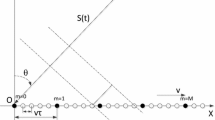Abstract
Aiming at improving time delay estimation (TDE) in the case of single sensor, a novel method of constructing virtual sensor array is presented, and furthermore the MUSIC delay estimation algorithm based on the virtual array is proposed. The approach and complete procedure of the algorithm are given. The relationship between the number of virtual array elements and the constructed signal is studied, and the method of determining the minimum number of elements under the condition of estimation time delay accurately is given. The simulation experiments of the presented algorithm have been carried out from three angles of view. The least virtual array elements and the minimum subspace dimensions needed in this algorithm is verified. We obtained the performance of time delay estimated by the algorithm under sparse path and dense path conditions respectively. This paper also illustrated the high precision and high-resolution characteristics of the proposed method.














Similar content being viewed by others
References
Knapp CH, Carter GC (1976) The generalized correlation method for estimation of time delay [J]. IEEETrans ASSP-24(4):320–327
Chen J, Benesty J, Huang Y (2006) Time delay estimation in room acoustic environments: An overview[J]. EURASIP J Adv Signal Process 2006:026503
Azaria M, Hertz D (1984) Time delay estimation by generalized cross correlation methods[J]. IEEE Trans Acoust Speech Signal Process 32(2):280–285
Zhou Y, Zhong L, Cai H et al (2017) White light scanning interferometry based on generalized cross-correlation time delay estimation[J]. IEEE Photonics J 9(5):1–11
Zhang Q (2017) Zhang L. an improved delay algorithm based on generalized cross correlation[C]. information technology and mechatronics engineering conference. IEEE:395–399
Pinhui KE, Zhifan YE, Zhang S et al (2018) On the cross-correlation distribution of d-Ary generalized Legendre-Sidelnikov sequences[J]. Chin J Electron 27(2):287–291
Cui Y, Zhu F (2018) A new bivariate integer-valued GARCH model allowing for negative cross-correlation[J]. Test: An Official Journal of the Spanish Society of Statistics & Operations Research 27:1–25
Liu WH, Wang YY, Wang B (2009) Adaptive time delay estimation based on least mean square sigmoid error with the presence of impulsive noises[J]. Journal of Dalian Maritime University 35(2):47–50
Ge F X, Shen D, Peng Y, et al. (2004) Super-resolution time delay estimation in multipath environments[C]. Wireless Communications and NETWORKING Conference. WCNC. IEEE, 2004:1121–1126
Gao Y, Xue J, Chang Y, et al. (2017) An MDL-MUSIC joint time delay estimation method for LTE PRS[C]. international symposium on Wireless communication Systems. IEEE
Liu Q, Han SW, Ma XS (2014) Research of time delay estimation based on higher order statistics[J]. Appl Mech Mater 530-531:550–553
Leng W, Wang G (2010) False peak restraint of DOA estimation using element adjustment and virtual array transformation[C]. IEEE ICWITS IEEE:1–4
Chen J, Li J, Li P et al (2014) Joint DOD and DOA estimation for high speed target using Bistatic MIMO radar[J]. Int J Antenn Propag 2014(1):1–10
Varma K, Ikuma T, Beex A A. (2002) Robust TDE-based DOA estimation for compact audio arrays[C]. Sensor Array and Multichannel Signal Processing Workshop Proceedings. IEEE, 214–218
Guibo ZHANG (2013) Peng, et al. wideband direction of arrival estimation with linear Array: analysis and closed-form formulae[J]. Chin J Electron 22(4):779–783
Arifianto D, Wirawan, Atmaja BT et al (2017) Azimuth tracking of underwater moving sound source based on time delay estimation using hydrophone Array ☆[J]. Procedia Engineering 170(1):169–176
BouDaher E, Ahmad F, Amin MG (2014) Sparse reconstruction for direction-of-arrival estimation using multi-frequency co-prime arrays. Eurasip Journal on Advances in Signal Processing 2014(1):168
Xia T-Q (2015) Joint diagonalization based 2D-DOD and 2D-DOA estimation for bistatic MIMO radar. Signal Process 116:7–12
Kim B, Kim S, Lee J (2018) A novel DFT-based DOA estimation by a virtual Array extension using simple multiplications for FMCW radar. Sensors (Basel, Switzerland) 18(5):1560
Spencer TC, Fallon JB, Shivdasani MN (2018) Creating virtual electrodes with 2D current steering. J Neural Eng 15(3):035002
Raghavan RS (2018) Coherent airborne MIMO detection of multiscatter targets. IEEE Trans Aerosp Electron Syst 54(2):978–991
Fan Di, Study on signal processing technology and their applications in ultrasonic detection of sediments thickness, Shandong University of Science and Technology(SDUST), China, 2010.6
Lv Changzhi, Li Weikuo, Song Jun, Fan Di, Lu Xiushan (2016) Optimization Design of low Power Consumption Kalman Filter Based on field programmable gate Array. J Nanoelectron Optoelectron,11(6):677–684
Li Y, Ma H, Cheng L et al (2018) Method for bearing estimation of target for amplitude modulation radio-based passive radar application. Electronics Letters 54(6):383–384
Liu F, Du R (2016) LPWS Algorithm for Wideband Spectrum Sensing. Wireless Pers Commun 91(3):1259–1270
Acknowledgements
This paper partially aided by Shandong Province Young Scientist Foundation (BS2012DX034), China Postdoctoral Science Foundation (2012 M521361), Shandong Province Natural Science Foundation (ZR2012EEM021), Project of Shandong Province Higher Educational Science and Technology Program (J13LN17), SDUST Research Fund (2010KYTD101), and Project of South Africa/China Research Collaboration in Science and Technology (2012DFG71060).
Author information
Authors and Affiliations
Corresponding author
Additional information
This article is part of the Topical Collection: Special Issue on Fog/Edge Networking for Multimedia Applications
Guest Editors: Yong Jin, Hang Shen, Daniele D'Agostino, Nadjib Achir, and James Nightingale
Publisher’s note
Springer Nature remains neutral with regard to jurisdictional claims in published maps and institutional affiliations.
Rights and permissions
About this article
Cite this article
Fan, D., Zhu, C. & LV, C. Time delay estimation algorithm based on virtual Array and MUSIC for single sensor system. Peer-to-Peer Netw. Appl. 12, 1519–1527 (2019). https://doi.org/10.1007/s12083-019-0719-8
Received:
Accepted:
Published:
Issue Date:
DOI: https://doi.org/10.1007/s12083-019-0719-8




